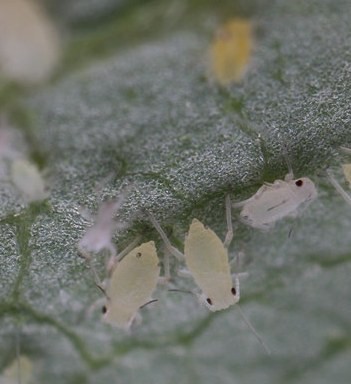Soybean aphid
(Aphis glycines)

Description
The soybean aphid (Aphis glycines) is an insect pest of soybean (Glycine max) that is exotic to North America. The soybean aphid is native to Asia. It has been described as a common pest of soybeans in China and as an occasional pest of soybeans in Indonesia, Japan, Korea, Malaysia, the Philippines, and Thailand. The soybean aphid was first documented in North America in Wisconsin in July 2000. Ragsdale et al. (2004) noted that the soybean aphid probably arrived in North America earlier than 2000, but remained undetected for a period of time. Venette and Ragsdale (2004) suggested that Japan probably served as the point of origin for the soybean aphid's North American invasion. By 2003, the soybean aphid had been documented in Delaware, Georgia, Illinois, Indiana, Iowa, Kansas, Kentucky, Michigan, Minnesota, Mississippi, Missouri, Nebraska, New York, North Dakota, Ohio, Pennsylvania, South Dakota, Virginia, West Virginia, and Wisconsin. Together, these states accounted for 89% of the 63,600,000 acres (257,000 km2) of soybean planted in the United States in 2007. The soybean aphid possesses a heteroecious holocyclic life cycle, which means the insect alternates hosts and undergoes sexual reproduction for at least part of its life cycle. Soybean aphids overwinter as eggs on their primary hosts, buckthorn (Rhamnus spp.). Eggs can be located near buds or within crevices of branches. With a mean supercooling point of −34 °C (−29 °F), eggs are well-adapted for surviving cold winters. In two studies, the quantity of overwintering eggs had a strong positive correlation with the severity of soybean aphid outbreaks in the following spring. Eggs begin to hatch into fundatrices when temperatures in the spring reach 10 °C (50 °F). Colonization of buckthorn by soybean aphids in the spring can lead to curling of leaves and twigs. Near the blooming stage of buckthorn, fundatrices reproduce parthenogenetically to give viviparous birth to alatae. These winged soybean aphids begin the spring migration to their secondary host, soybean. Soybean aphids go through approximately 15 generations on soybean, all of which are primarily composed of apterous females produced through viviparous parthenogenesis. Each generation passes through 4 instars and can range from 2 to 16 days in length, with higher temperatures increasing development and decreasing generation time.
Taxonomic tree:







